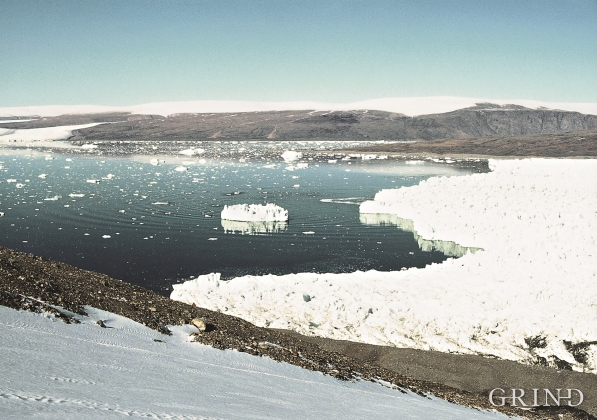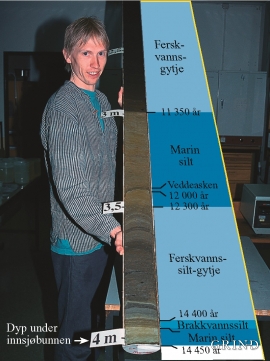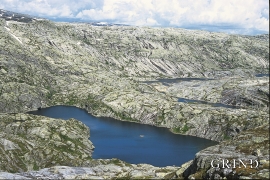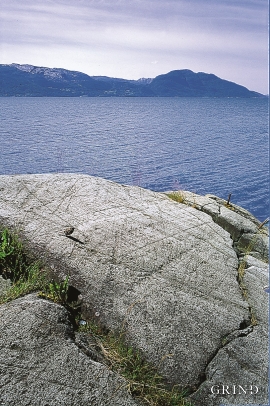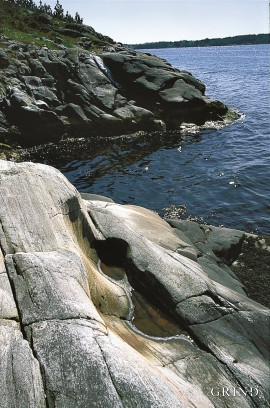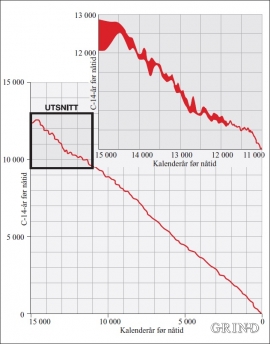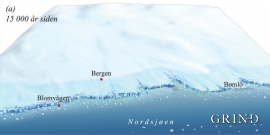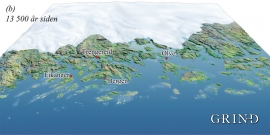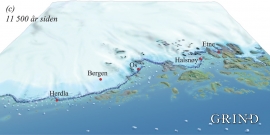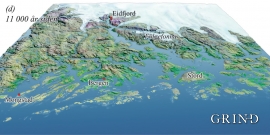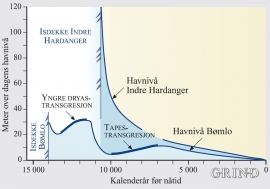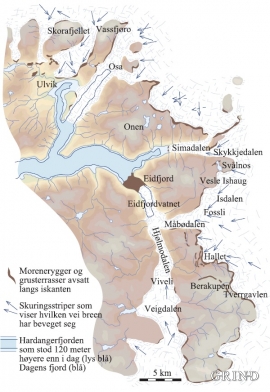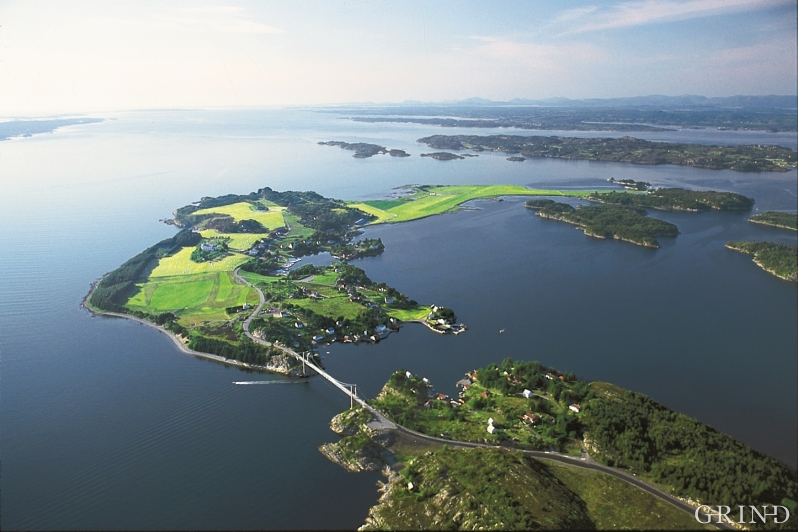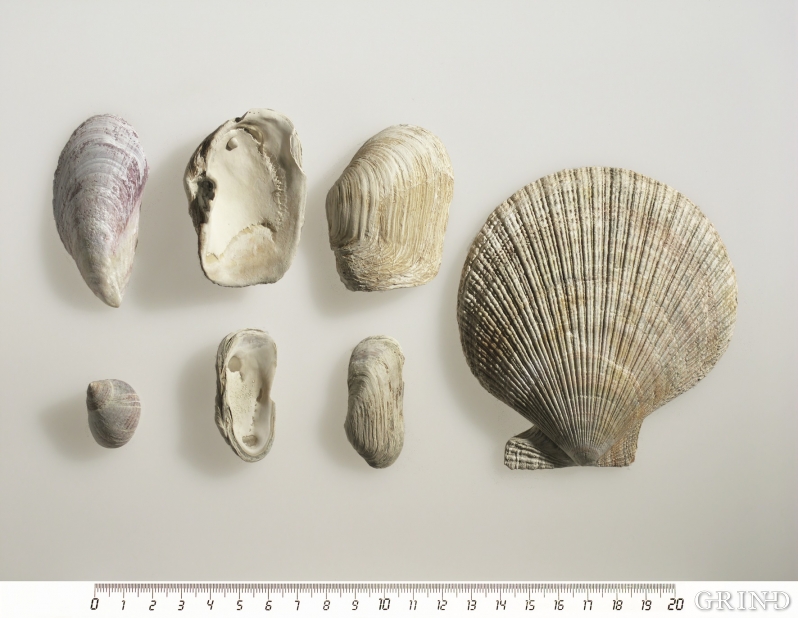Published: 28.10.2004 | Author: Jan Mangerud
I perioden 14 500–11 500 år siden var landskapet i Hordaland preget av nærværet av innlandsisen, slik som her fra vestkysten av Grønland i dag. (Jan Mangerud)
Bulldozer and creator
The continental glacier that covered Hordaland was like a great power that had decisive influence over our natural history. The glaciers which at the beginning of the last ice age (more than 100,000 years ago) grew out from Folgefonna, Hardangerjøkulen and other mountainous areas, chased animals and birds, and most likely also humans in front of their paths. Small animals, plants and trees were mercilessly run over and crushed to powder under the thick ice. Even the hard bedrock got torn up and scoured by the ice, which did not give up before it reached the outer edges of the continental shelf. First 14,500 years ago, the climate became mild enough that the outer coastal strip of Hordaland once again became ice-free. Plants, animals and people started to migrate in to a landscape that was golden, with flecks of grey moraine and sand between smoothly polished rock outcrops - as our present warm interglacial was born.
Nature's archive
If we wish to study cultural history, we consult the national archives and church books. If we wish to study natural history, we must go to the archives where this story is recorded and preserved. In lakes roughly 0.5 mm of sediment are usually deposited each year. The first layer got laid down on lake bottoms when the continental glacier receded. Each year a new sediment layer is laid down, like a carpet over the older one. Today, sediment from lake bottoms gives us a natural archive, sort of like a pile of papers in an office archive, with the oldest records in the lowest layers, and younger and younger ones above these. We can study this archive by taking a core through the sediment layers on the bottom of the lake. Similar records can be obtained from bogs and fjord bottoms. River and glacier archives are more complicated in their construction and therefore more difficult to interpret, but these are also very important.
In Hordaland, as in the rest of Norway, we can simplify geological material into two main types: The one is bedrock, that is, the hard rock surface. This record is from several hundreds of millions to two billion years; from a human perspective, an incredibly long time. The other main type is comprised of the loose deposits that cover this hard ground, for example, all growing soils, moraines, sand, clay, peat, avalanche deposits and sediments on the bottoms of lakes and fjords. The loose deposits are geologically speaking very young and they are nature's archive for the time from the ice ages until today.
The last ice age can be compared to a war, where not only animals and people were chased from their land, but where practically speaking all archives or our previous history were destroyed or flattened to the ground. The loose sediment deposits laid down during interglacials are the first to get eroded away during subsequent glacial periods (ice ages), before the glaciers begin to scour at the hard bedrock. The last glacial maximum therefore represents an almost insurmountable barrier to our knowledge about our natural history earlier in time. But, as in all wars, there are things which miraculously survive, though we cannot explain how or why. In Hordaland, just such a miracle occurred in Fjøsanger.
We have had about 40 ice ages in Norway the past 2.5 million years, interrupted by as many warmer, or in any case milder, interglacials with a climate similar to that of modern day. As one can understand from the above, we must unfortunately concede that we will never be able to find archives that will tell us of Hordaland's history through the vast majority of these ice ages and interglacials. Today, we see only the sum total of all the ice age's work, expressed as deep fjords, valleys and lakes. This is discussed in the chapter about landforms.
Layers from the last interglacial period
At Fjøsanger, on the outskirts of Bergen, a sensational find was made in 1975-77: layers that showed the development of forest, animal life and climate in Hordaland through the entire previous interglacial period, known as the "Eemian". On a global scale this is still a very unusual find for areas that were covered by ice during the last ice age. The Fjøsanger archive survived the last ice age and was the first discovery in Norway that showed how conditions were during the interglacial period, before the onset of the last ice age's 100,000 cold years.
The discovery is described in more detail under the Bergen Municipality (*p. R344) Here it will only be mentioned that the climate in Hordaland was roughly the same as in southern Denmark today. We could perhaps wish for these conditions today, too. But it was - on a geological timescale - a short-lived pleasure. The entire Eemian Interglacial lasted only about 15,000 years, from 130,000 to 115,000 years ago. This is characteristic for the last roughly 1 million years: Each ice age lasted ca. 100 000 years, while the interglacials lasted for 10-30 000 years.
The cold sets in
The Fjøsanger archive is exciting also because the layers which were deposited during the transition from the Eemian interglacial to the last ice age are so well preserved. The first climatic change happened unbelievably quickly, in just the span of a few hundred years. The forest on land and warm-loving animals in the sea disappeared almost instantaneously. The explanation is that the Gulf Stream changed its course. Instead of sending large amounts of warm water northwards along the Norwegian coast, most of the water was directed more toward the south, in toward France and Portugal. But the climate varied also during the ice age. After the glacier first advanced almost to Fjøsanger, a milder period set in and the ice disappeared, practically speaking, from the whole of Scandinavia, before it again got colder and the glacier advanced over Fjøsanger. The moraine deposited by this glacier (called the Bønes moraine) comprises the youngest layer at Fjøsanger.
Hordaland then entered an entirely unknown period. We have no finds from the time between the Bønes moraine, which is ca. 90,000 years old, and the Blomvåg find which is roughly 14,500 years old (discussed below). This means that nearly 80,000 years of Hordaland's natural history is unknown. Nonetheless, there is likely to be layers from this period preserved in Hordaland, and we encourage readers who see layers or fossils under moraines to report these.
In caves in Sunnmøre, layers have been found with thousands of bones from animals and birds dated to 30,000 years old. These are mostly sea birds, seals and fish which today live on Svalbard, but also reindeer and grouse, which suggest that at least a wide belt along the entire west coast was ice free at that time. After this, the valley and fjord glaciers joined together to form a mighty continental glacier that reached all the way out to the outer continental shelf, roughly 25,000 - 20,000 years ago. Here, giant icebergs calved and sailed majestically out to sea. From the ice edge the surface of the glacier rose toward the coast and in over land to the highest knobs of ice overlying Hardangervidda. At this time one could have walked from Vikingbanken nearly to Moscow without seeing anything but ice and snow. In sunshine there would have been a beautiful, glistening snowy surface. But, it was devoid of life. One had to travel all the way to Hamburg in order to find ice-free land, but from there the tundra with its permafrost stretched far into the south of France. Only grass, moss and alpine flowers could tolerate the climate there. The trees and most of the animals that live in Hordaland today would have had to migrate all the way to the Mediterranean in order to survive. We call this period roughly 20,000 years ago the "glacial maximum", because the continental glaciers covering Scandinavia and North America were at their greatest extent then, though this was in fact near to the end of the last ice age.
The start of a new time - our own interglacial
One day the ice began to loosen its grip. Life began gradually to take hold from the bare earth. Our nature: pine forests with deer, grass and sparrows, earthworms and ants, lakes with marshy edges, migrating bird's routes and rest stops and rivers stocked with local salmon; all of these mark the final generation in the development of Hordaland's nature, which began first when the ice melted and the glaciers receded back.
The oldest layer that shows an ice-free Hordaland coast is found at Blomvåg in Øygarden (*see p. R374). The find was made in 1941 and we scientists dream that similar finds will be made today so that the deposits can be studied using modern methods. But the museum samples from Blomvåg have been thoroughly studied and dated using the C-14 method to an age of 12,200 - 12,700 C-14 years, which is comparable to 14,200-14,600 calendar years *(see pane p. ?T69 - står ingenting i boka). Finds from among other things reindeer, a large Greenland whale and different types of shell, show that the climate then was roughly the same as in Finnmark today. We do not know how far the ice edge receded in towards land. There are simply no records to show us this.
However, we do know that it became colder again. The famous bone-bearing layer at Blomvåg is covered by a ground moraine that shows that the ice again advanced over Øygarden and out into the ocean. This was, however, a short cold period, only 200-300 years long, and parts of Sunnhordland's coast remained ice-free.
Even more mild: Allerød-time.
A little less than 14,000 years ago, conditions again became so warm that the glacial tongue melted rapidly back. When the glacier lost its foothold on the islands and islets, it calved rapidly in towards the deep fjords because giant mountains of ice broke off from the front of the glacier. This milder period is named after the city of Allerød in Denmark, where deposits from this period were first discovered roughly a hundred years ago. From the Allerød period, ca. 14,000 - 12,800 years ago, we have found horse mussels, common mussels and periwinkles in Bergen, Os and Eikanger, also as far inland as Ølve and Trengereid. These shells depended on the waters of the Gulf Stream, so in Allerød time conditions in Hordaland must have been like those along the Troms-Finnmark coast today. On land there were thickets of green willow and dwarf birch with lush flower meadows between them. It was still too cold for most types of tree, but the absence of birch forest can perhaps also be attributed to the long migration time from S. Europe (*p. ingen sidetall oppgitt i boka, s. 71).
But the ice age was not over: Yngre Dryas-time
During Allerød time the ice front receded, as mentioned, far into the fjords and valleys. Animals and plants from the whole of Europe were en route northwards to exploit the new land becoming exposed and adapt to the steadily warming climate. But they had got it wrong. The climate reversed, abruptly and dramatically. This climatic catastrophe was caused by the Gulf Stream again turning south toward Portugal, instead of flowing north to us.
The ice in Hordaland grew thicker and advanced, mowing down vegetation on land and ploughing up clay and shell from the sea floor. But it didn't take everything with it. Perhaps there was too little time. The shells from the Allerød were of course disturbed by the ice, crushed and stirred up with clay and gravel. But sufficiently large bits survived to make it possible to find them today, identify the species, and date them using the C-14 method. This allows us to decide how far inland ice-free conditions reached during the Allerød, before the last glacial advance.
The Younger Dryas is the name of the roughly 1,000 year-long cold period we are talking about (12,800 - 11,500 years ago). The name comes from the beautiful alpine flower mountain avens, which in Latin is called Dryas octopetala . Leaves from this were found in clay in Denmark already at the end of the 1800s, and this helped researchers then to understand that there had been a cold period.
But back to the ice sheet in Hordaland, which advanced from the inner fjords with incredible speed, roughly 50 m per year. The ice sheet was up to 1500 m thick along the fjords. On land, and especially in the mountains, the thickness was less, but it acted nonetheless like a bulldozer as it moved over Hordaland.
The ice stopped at Herdla. The loose deposits that form this beautiful island were laid down by the ice front when it stopped advancing at the end of the Younger Dryas (*p. R350). Geologists use the name Herdla moraine for the entire end moraine that was formed in Hordaland at that time. This corresponds to the Ra moraine through Østfold and Vestfold municipalities. We draw the Herdla moraine on a geological map with a red line. In nature it appears as a green belt from north to south through Hordaland, because there is deeper soil here and therefore better growing land. Ironically, several of the best farms in the municipality can thank a 12,800 year old climatic deterioration for their good soil. The series of farms, LeirvågAustrheim-Manger-Husebø-Herdla, lie on this moraine, either on moraine soil or on clay and sand deposited in the sea outside of the ice margin. The same applies for Hjellestad-Milde in Fana, much of Os and Fusa, and not least Halsnøy in Hardangerfjord (*p. R259) and the villages Skånevik (*p. R245) and Etne (*p. R242).
Finally an end to the Ice Age
The most dramatic climatic change we know of in Hordaland, and for that matter in all of Europe, occurred 11,500 years ago, at the end of the Younger Dryas. The Gulf Stream changed course from its direction toward Portugal to instead "gush" into the North Sea with full force over the span of perhaps only 20-50 years. And with it came warmer air. We do not know which was the "chicken" and which was the "egg", but it is certain that the Gulf Stream and the warm south-westerly air reinforced each other, as they do today. Over the course of a hundred years or so, the climate became almost like that of today.
The ice-melt picked up speed. The climatic change took the life of the Scandinavian ice sheet almost instantaneously; every summer more snow melted than fell during the previous winter, all the way up to the highest parts of the glacier. Nonetheless, it still took time for such a thick ice sheet to disappear. If we look to Hardanger fjord, we can imagine that the ice front calved back from Halsnøy to Eidfjord in just 200-400 years. We cannot date the event more precisely than this, but if we think that the 1200 m deep fjord was filled by an ice sheet that inland would reach up to 2,000 m above sea level, we can understand that there were huge volumes of icebergs that sailed out from the coast of Hordaland over the course of a few hundred years; much more than along the East Greenland coast today.
Even though much of the ice sheet calved into large icebergs which first melted when they came out on the ocean, we figure that 10-15 m of ice melted from the lower part of the glacial surface during the summer half of the year. The melting of ice gives nearly as much volume of water as rain, that is, 10,000 - 15,000 mm, expressed in meteorological measures. Today, the annual rainfall is less than 2,000 mm in most parts of Hordaland. It is easy to understand that a volume of water equal to more than 5 times the entire annual rainfall today would give some gigantic, thundering glacial rivers. These carried large quantities of sand and gravel under and alongside of the glacier forward to the ice edge. Nearly all of the sand- and gravel pits in the municipality arise from such glacial-river deposits.
When the glaciers had calved into the deep fjords, they tended to stop when they got solid ground under them. Much of the gravel was therefore deposited as glacial river deltas in the inner fjord areas. Since the land has since risen, we find these deltas roughly 50 - 60, even up to 125 metres above sea level today. They appear as flat terraces that are built up of sand and gravel. In the rainy Hordaland climate they make good agricultural land; in eastern Norway such terraces are dry pine barrens because the rainwater seeps so quickly down in the porous gravel. Geologically, they show both where the glacier front stopped during the ice melt, and how much the land has risen. Such terraces are found in most of the valleys in Hordaland, such as in Modalen, (*p. R428) near the ferry wharf at Kvanndal, in Rosendal, at Odda, Etne (*p. R242) Fana Church, Ulven (*p. R312) and many other places.
The glacier comes alive
Now we might have expected that the glacier would disappear completely and quickly. But nature gives us surprises. In several places we find moraine ridges that show that the glacier in fact made small advances. This can be seen most clearly in the mountain regions of Ulvik - Eidfjord. Continuous, sharp moraine ridges can be mapped here over large distances ( *p. R520) and the glacier can be reconstructed in great detail. A long valley glacier flowed out from Måbødalen, from Fossli to Eidfjord, where the big gravel deposit between Lake Eidfjordvatnet and the fjord was laid down as a delta at the front of this glacier (*p. R516)
Concluding thoughts
Ice ages appeal to fantasy. It is our recent natural history. The first humans who came to Norway saw this great ice sheet. Some youths were probably so curious that they climbed on it. Perhaps they left behind remains of reindeer meat for refrigeration in cracks in the ice. The landscape was different, but not more than that we can imagine glaciers in the fjords, and a higher sea level. Yes, and also a vegetation that resembles more that of mountain regions today. It was different, but nonetheless recognizable. The main features in the landscape were as today. The humans were our forefathers. Animals, trees and flowers that migrated in still have their ancestors living around us. Even though we only know a fragment of the story. Some of the most important finds have been made by amateurs who reported their discoveries to specialists. Use your eyes in nature. Experience its history and report it if you see something exciting.
Traces of the big ice sheet
Student Øystein Lohne med et naturens arkiv – en borkjerne fra bunnen av Langavatnet på Drange i Os. Selv om vatnet i dag ligger 50 meter over havet, gikk havet opp hit da det dypeste laget ble avsatt. Brakkvannssedimenter, datert til 14 400 år siden, viser fasen da Langavatnet ble hevet opp av sjøen og ble et ferskvann. Men for 12 300 år siden, noen hundre år før vulkansk aske fra Island regnet ned, ble Langavatnet igjen en havbukt, denne gang for en varighet av 1000 år. Til slutt sørget landhevningen for at vårt Langavatnet så dagens lys, representert med de øverste tre metrene med brune sedimenter, avsatt i ferskvann.
Traces of the big ice sheet
The whole of Hordaland was influenced by the continental ice sheet during the last ice age. Daily we wander by what at that time was the basement of the ice sheet. Above our heads there has been from several hundreds to 2,000 metres of ice, depending on if we are on the fjord or up in the mountains. Fjords, valleys and lakes are the products of ice, but researchers today do not have the possibility to evaluate how much the ice sheet scoured during the last ice age as opposed to during earlier ice ages. Certainly, the last ice age is responsible for the bare rock, polished clean by the ice, that is exposed over huge areas. "In the cracks there is only the spring of life to be seen", wrote Bjørnson. This describes Hordaland well, where small patches of earth lie scattered between naked rocky outcrops.
Much smaller clues, but more important for reconstructing the ice sheet and its development, are glacial striations (theme *p. ingen oppgitt på s. 68) These striations are carved into the bedrock by sand and stone that was lodged in the underside of the ice sheet and they show the direction in which the ice moved. The striations are not of the same age everywhere in Hordaland. On the outer islands and islets they point almost directly toward the west and show the ice movement at the time the ice reached just beyond the coast. The glacial striations near the tops of mountains are also thought to be from this time. When the ice sheet grew thinner it had to move along valleys and fjords. In towards land most glacial striations from the glacial maximum are therefore erased by younger glaciers, and those we find run parallel with the valleys and fjords. By far most of the glacial striations have been eroded away over thousands of years since the ice age. Exceptions can be found in especially fine-grained and hard bedrock. It is nonetheless best to search for them along the coast, between the low and high tide marks.
Another trace left behind by the great ice sheets are moraines. Everything the glacier picked up along its way did not get transported out to sea; some of it was on its way under the glacier when its time was over. These ground moraines were then deposited where they accumulated under the ice, and are found as flecks or larger patches throughout the municipality. (*p. T74) Huge stones that lie unprovoked on mountain tops, on islands along the coast, and many other places, are called glacial erratics. They lay on the surface of the ice, or inside of the glacier, and as the glacier melted, were dropped wherever they happened to be at the time.
Kettle holes (*s. ingen oppgitt på s. 68 i boka) form in rushing rivers. But, kettle holes, often from 2 to nearly 10 metres in diameter, are also found along modern day rivers, for example at Fykesund, (*p. R489) Eidelandsosen (*p. 318) and Fossli. These are formed in large rivers under the ice. Smaller, strange, bending streams (called p-forms) are formed by water with a colossal velocity in thin channels underneath the ice.
Kurve over brefrontens bevegelser i Hordaland gjennom de siste 140 000 årene. Kurven viser hvor langt ut brefronten lå til enhver tid, i et øst-vestprofil over Hordaland. For 120 000 år siden var det ingen bre (Fjøsanger mellomistid), og i dag er det bare Hardangerjøkulen og Folgefonna. Størst var breen for 25 000–30 000 år siden, da vi ser av kurven at brefronten nådde helt ut til Eggakanten, ytterst på sokkelen. Figuren over viser detaljer av denne kurven. Lagene ved Blomvågen viser den første isfrie perioden for om lag 14 500 år siden. Men breen gikk over disse lagene igjen før den smeltet og kalvet langt innover Osterfjorden og Hardangerfjorden omkring 13 500 før nåtiden. I den kalde yngre dryasperioden ekspanderte breen på nytt og la igjen Herdlamorenen. (Jan Mangerud/Eva Bjørseth)
Calendar years and C-14 dating
If I ask, "What is a year?", I will usually get the answer that a year is from New Year's Eve until New Year's Eve the following year. This is of course correct. Nonetheless, we researchers would call this a "calendar year". The reason is that when we date the age of a Stone Age village, or when a glacier melted away in Hordaland, we cannot go to a calendar to figure it out. We must date it using other methods, and it so happens that the "years" then are not exactly calendar years.
The dominant method for dating archaeological and geological finds that are younger than 50,000 years old is the C-14 method. The age is then given in C-14 years. The method is also called the radiocarbon-dating method because the C-14 atom is radioactive. The principle for dating is simple. Carbon consists almost entirely of atoms with an atomic weight of 12, therefore called C-12. Cosmic radiation in the upper atmosphere produces some C-14, however. These form carbon dioxide (CO2 ) in the same way as C-12 atoms do, and they likewise get taken up by plants through photosynthesis. Animals and people eat the plants, and one another. This means that the ratio of C-14 to C-12 is the same for all organisms as long as they live. Once they die, they stop taking up new carbon. Since C-14 is radioactive, it breaks down and after 5570 years there is only half of the amount left. The amount of C-12, however, remains constant. If we measure the C-14 content in a branch deep down in a bog and find that the C-14 content is half as much as that of living plants, then it must be 5570 years old. If the amount is halved again, that is, 1/4, then it must be 11,140 years old.
It is easy to understand that an assumption for the method is that the C-14 content in the atmosphere has been constant back in time. When the method was first discovered, researchers optimistically believed this, but we have since learned that this is not entirely true. An exception was demonstrated by the use of tree-ring dating of trees. The wood in an annual ring dies when the ring is formed. By counting tree rings back in time and then dating trees, we can get an age for each ring measured both in C-14 years and in calendar years. In this way the two timescales can be compared.
Trees adopt a pattern of thicker and thinner tree rings that is determined by the weather. In warmer summers the rings will be thicker; in cold years, thinner. If we lay two trees that are cut down at the same time beside each other, their tree ring patterns will be identical. Let's say that these are 400 years old, which is not unusual for oak. If we then find a log with 500 tree rings in an old house, where the outer (that is, younger) 200 rings have a pattern that overlaps with the inner rings (that is, the oldest) in the newly cut down trees, then we have come 700 years back in time. The use of tree rings in this way is called dendrochronology, after the Latin word for tree. To come very far back in time, researchers have used hundreds of logs found in old buildings, and not least in the sand banks along the Donau River in southern Germany. Currently, logs have been found along the Donau that are dendrochronologically linked together nearly 12,000 years back in time. The annual rings are also dated using the C-14 method. This has provided the basis for calibration curves such as those shown in the figure.
To ascertain the certainty of the calibration of C-14 years to calendar years, the time must be divided in two. As far back as tree rings have been counted we can consider the calibration to be certain; eventual mistakes are thought to be on the order of less than 20 years. If we go further than 12,000 years (ca. 10,300 C-14 years) back in time, that is, to the end of the last Ice Age, the uncertainty is much larger. For this time the curve is based on counting annual rings in lakes, dating of corals, and other methods. Other modifications to the method can be expected as new research results are published. Nonetheless, we have chosen to use calendar years throughout this book.
Kart (a)
Hordaland idet de ytterste øyene kommer fram av den tilbakesmeltende brefronten. Når det blir litt varmere, avsettes Blomvåglagene. Stranden lå 20–30 meter høyere enn i dag. På dette og de andre kartene ser vi på skrå inn mot Hordaland. Innlandsisen og havnivået er tegnet slik vi mener de var til hver tid.
Kart (b)
Etter at breen igjen hadde vokst og gått over Blomvåglagene (kart a), smeltet den i allerødtiden langt innover i landet Vi vet ikke hvor langt, så her er det tegnet en hypotetisk brefront. Øygarden lå nesten helt under sjøen, og det var et sund gjennom Bergensdalen.
Kart (c)
I den kalde yngre dryasperioden vokste innlandsisen raskt og avsatte Herdlamorenen der framrykket stoppet. Landhevningen gikk saktere på grunn av øket isvekt, mens verdenshavet steg på grunn av bresmelting andre steder i verden. Strandlinjen fra denne tiden ligger på 60 moh. ved Os og 30 moh. ute ved kysten.
Kart (d)
Istiden er egentlig slutt. Breen har på noen få hundre år smeltet langt inn i landet og kalvet inn hele Hardangerfjorden. Men fremdeles gjør den de siste krampetrekningene og stopper opp eller rykker fram. Særlig tydelige morener fra denne tiden finnes i Eidfjord og Ulvik. Landet stiger i full fart; stranden ligger 125 meter høyere enn i dag i Ulvik og 10 meter høyere ute ved kysten.
Raised beaches and shells on land
I often travel out into the mouth of the fjord. The waves and sea give me the feeling of endless time and space. Nonetheless, the shoreline changes. Not so much over the course of a human lifetime, but over generations it seems. If one talks to a farmer and digging machine driver, they will tell you of finds of shells high above today's shoreline. The highest indicators of sea-level, and those which are easiest to see, are the glacial-river deltas that we have discussed in the chapter about the Ice Age (*p. tema ingen side oppgitt s. 72 i boka). These terraces were once fine sandy beaches, finer and more abundant than we have today in Hordaland, but with colder water. If we measure how high the terraces lie, we can find out how high the sea level was at that time. The highest terraces in Hordaland are in Ulvik, where they are at 125 metres above sea level (*p. R461). The large sand flats at Stend and Fana vicarage are nearly 60 metres above sea level, while the highest indicators of sea-level on the outer islands in the county are at only 20 - 30 metres elevation.
The raised beaches are caused by land upheaval, which of course will be greater inland than out by the coast. The earth consists of a crust of solid bedrock which floats on an interior of melted magma. The 2-3000 metres-thick ice sheet covering Scandinavia was so heavy that it pressed the earth's crust down and in so doing pushed the melted magma to the side. The land began to rise up as soon as the ice sheet grew thinner, but magma is much more viscous than syrup. Therefore, the land remained suppressed for a time even after the ice had melted. The ice was thickest toward the centre of Scandinavia, and therefore the raised beaches are higher in innermost Hardanger than they are out on the coast.
But there are also other factors causing beaches to move higher or lower. Here, we will just discuss one of these, namely, that there is not always the same amount of water in the ocean. During the ice age enormous amounts of water were stored in ice sheets on land, especially in Scandinavia and North America. The process is easy to understand if we remind ourselves that the world's oceans are expected to rise 5-6 m if the Greenland ice sheet of today should melt, and roughly 60 m if the one on Antarctica were to melt. During the ice maximum of the last ice age, ca. 20,000 years ago, there was so much ice on land that the world's oceans were 120 m lower than today. Outside of, for example, Africa and southern Europe, there was dry land down to what today is 120 m water depth. When fishermen catch peat, reindeer bones or mammoth teeth in their nets in the North Sea, this is the explanation.
In Hordaland there was an exciting race: the land rose as the weight of the Scandinavian ice sheet decreased. The sea level rose also because the Scandinavian and other ice sheets around the world melted. Which rose fastest? This is hard to answer. Obviously Hordaland has risen faster on average than the sea level, since old raised shorelines lie much higher than the shoreline of today. In inner Hardanger the land has always risen fastest. The race was more exciting nearer the coast of Hordaland. Here, the land rose more slowly, so the sea level was in with a chance. In two periods the sea rose faster than the land, both during the period from 13,000 - 11,500 years ago (the Younger Dryas) and from 9,000 - 7,000 years ago (the Tapes transgression). The fact that the oldest raised beaches lie 20-30 metres above sea level on the outer islands is testimony to this.
Landhevning og havstigning
De to kurvene til venstre viser hvordan strandlinjen har flyttet seg. I Indre Hardanger lå stranden 125 meter høyere enn i dag da breen trakk seg tilbake herfra for 11 000 år siden. Her steg landet først veldig raskt, faktisk 10–15 meter pr. århundre. Hastigheten avtok så jevnt. Det gamle skipreidenaustet i Kinsarvik ligger ikke stort høyere enn vi i dag ville legge et naust, så landhevningen der har nok vært mindre enn en meter det siste tusenåret.
Sør-Bømlo ble isfritt for vel 14 000 år siden, men vi ser at havet her stod bare vel 30 meter høyere enn nå fordi kysten var mye mindre nedtrykt enn i indre strøk. Da isen forsvant, steg landet raskere enn havet, og stranden forflyttet seg nedover. Men dette tok havet igjen i yngre dryas-perioden. Det skyldtes at landhevningen stoppet opp fordi breen vokste og rykket fram til Herdla–Halsnøymorenen, mens verdenshavene fortsatte å stige fordi breen i Amerika smeltet. Summen ble at havstigningen vant i denne perioden (yngre dryas-transgresjonen). Så snudde det helt igjen. Under den raske isavsmeltingen som startet inne i landet for 11 500 år siden, steg hele Norge raskere enn havet, slik også med Bømlo. Den hurtigste landhevningen skjedde de første århundrene etter 11 500 og ble så saktere etter hvert, til slutt så sakte at havstigningen enda en gang fikk overtaket. Igjen var det breen over Nord-Amerika som fortsatte å sende store mengder smeltevann ut i havet helt fram til for ca. 7000 år siden. Tapestransgresjonen kaller vi denne havstigningen under steinalderens varmetid i Norge. Siden da har Verdenshavene hatt nesten konstant nivå, havstigningen var ferdig, og konkurransen var slutt. Senere er Bømlo, Sotra og de andre øyene hevet om lag 10 meter.
- Andersen, B. G. 2000. Istider i Norge. Landskap formet av istidens breer. Universitetsforlaget.
- Anundsen, K.; Simonsen, A.1967. Et preborealt breframstøt på Hardangervidda og i området mellom Bergensbanen og Jotunheimen. UiB Årbok. Mat.nat. serie 7.
- Bondevik, S.; Mangerud, J. 2002.A calendar age estimate of a very late Younger Dryas ice sheet maximum in western Norway. Quaternary Science Reviews 21:1661–1676.
- Mangerud, J. 1976. Fra istid til nåtid. I: Hartvedt, G. H. (red.). Bygd og by i Norge. Hordaland og Bergen : 111–151.
- Mangerud, J. 1973. Hordalands natur, under og like etter siste istid. Frå Fjon til Fusa. Årbok for Nord- og Midthordland Sogelag 26:7–43.
- Mangerud, J. 1986. Spor etter istider og mellomistider. I: Fossen,A.B.(red.). Bergensernes fjellverden. Bind I. Fra istid til nåtid: 12–20. Hardanger Forlag A/S.
- Mangerud, J. 2000. Was Hardangerfjorden, Western Norway,glaciated during the Younger Dryas? Norsk Geologisk Tidsskrift 80:229–234.
- Aarseth, I.; Mangerud, J. 1974. Younger Dryas end moraines between Hardangerfjorden and Sognefjorden, Western Norway. Boreas 3:3–22.

